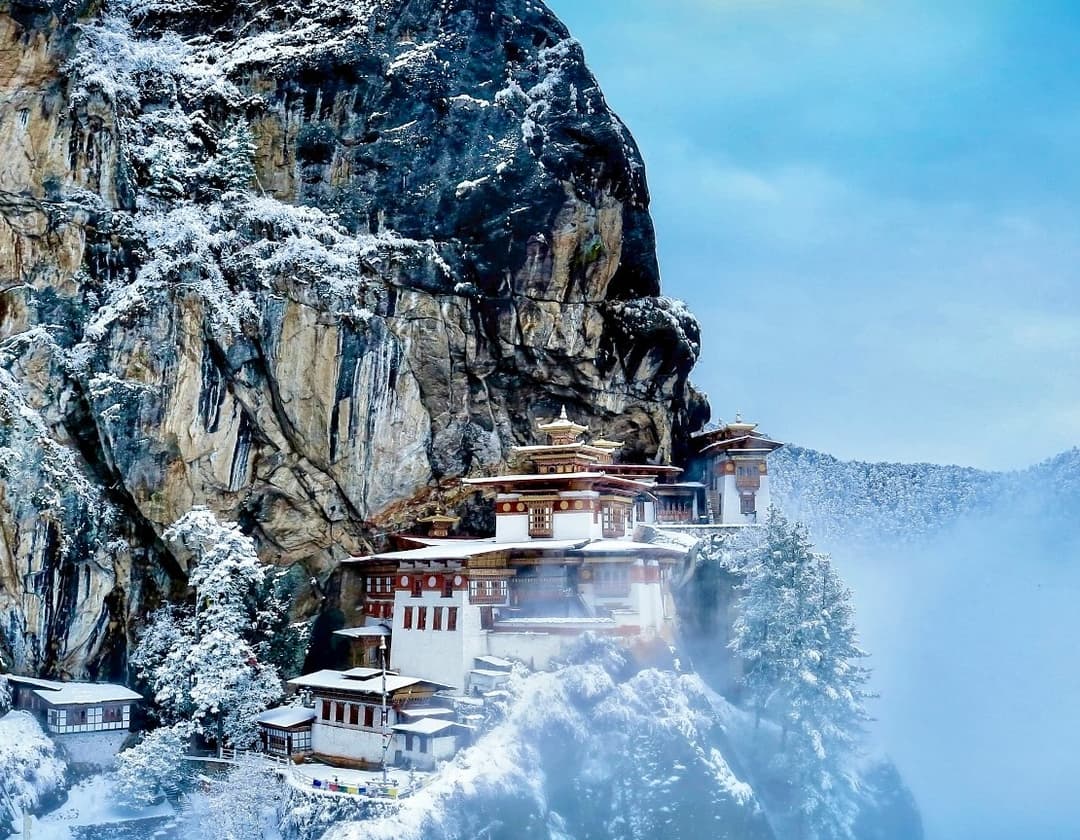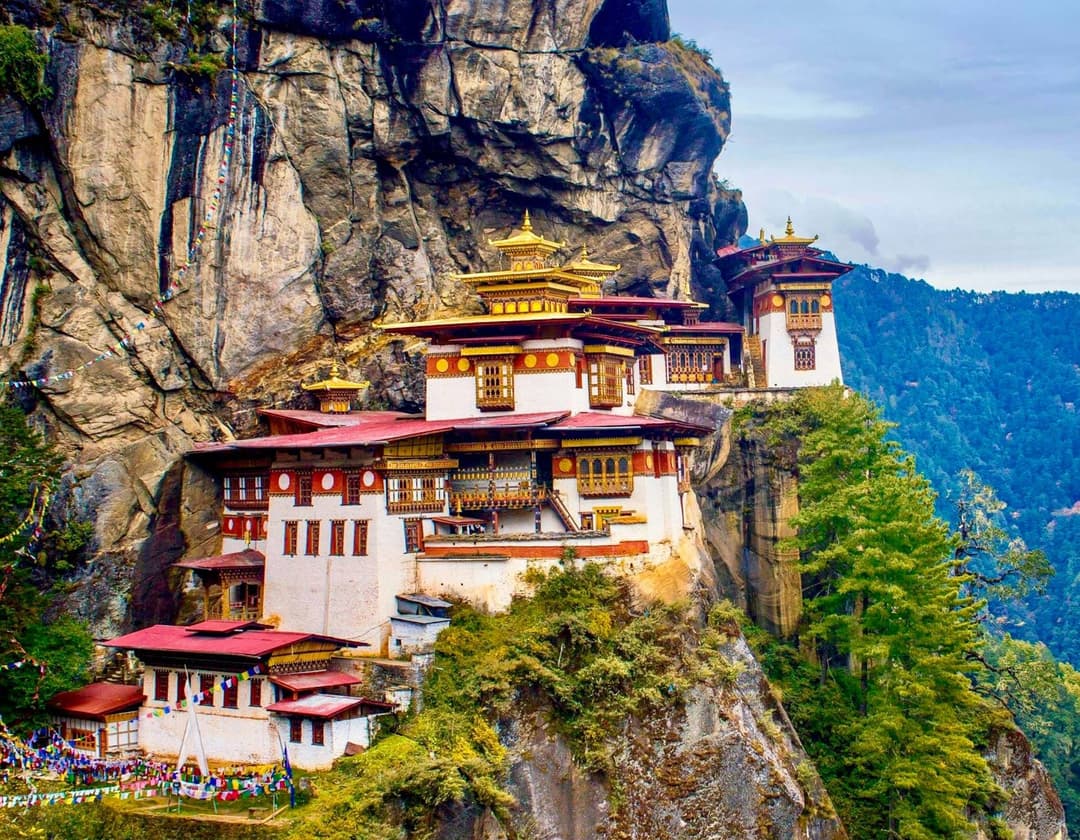Dive into the enchanting beauty of Bhutan with the 3 Nights 4 Days Bhutan Tour, designed to offer a comprehensive yet compact exploration of this mystical kingdom. This tour seamlessly combines the tranquil scenery of Paro with the dynamic cultural experiences of Thimphu. From scenic drives to the iconic hike to Tiger’s Nest Monastery, the itinerary is crafted to enrich your understanding and enjoyment of Bhutanese heritage and natural beauty. Ideal for both newcomers and those revisiting, this package ensures a perfect blend of adventure, culture, and relaxation, fitting effortlessly into a short visit or a weekend getaway.
At Druk Holidays, we pride ourselves on being the premier choice for the 3 Nights 4 Days Bhutan Tour, offering an expertly crafted experience tailored to showcase the very essence of Bhutan in a brief yet fulfilling package. Our dedication to service excellence, deep-rooted knowledge of Bhutan's culture and landscapes, and commitment to providing memorable and immersive experiences make us the top choice for travelers seeking a short but comprehensive exploration of this beautiful Himalayan kingdom. Choose Druk Holidays for your Bhutan adventure, and let us show you the best of what this unique destination has to offer in just four days, with the assurance of quality, comfort, and unforgettable memories.
Paro Exploration
Exploring Paro is a highlight of any visit to Bhutan, especially on a 3 Nights 4 Days Bhutan Tour. This charming town is not just a scenic delight with its lush valleys and historic architecture but also a cultural hub with deep historical significance. Here’s what makes Paro an essential part of your Bhutanese adventure:
- Rinpung Dzong: Known as the Fortress on a Heap of Jewels, Rinpung Dzong is an architectural masterpiece that serves both as a monastic and administrative center. Its intricate woodwork and imposing walls provide insight into the traditional Bhutanese art and architecture.
- Paro Taktsang (Tiger’s Nest Monastery): Perched dramatically on the edge of a 1,200-meter cliff, this iconic monastery is not only a symbol of human faith and perseverance but also offers breathtaking views of the surrounding mountains and forests. The hike to Tiger’s Nest is both invigorating and spiritually uplifting.
- National Museum of Bhutan: Housed in a renovated traditional watchtower, the museum presents a treasure trove of Bhutanese artifacts, from ancient statues and paintings to traditional costumes and weapons, offering a deep dive into the Bhutanese ways of life.
- Kyichu Lhakhang: One of the oldest and most beautiful temples in Bhutan, Kyichu Lhakhang dates back to the 7th century and is considered a key religious landmark. It provides a serene and sacred environment, perfect for reflection and appreciation of Bhutanese spiritual practices.
- Drukgyel Dzong: Although largely in ruins, this historic fortress offers a glimpse into the past strategic importance of Bhutan’s defensive structures. It also provides stunning views of Mt. Jomolhari on a clear day, making it a perfect spot for photography enthusiasts.
- Local Markets and Artisan Shops: Paro’s local market brims with vibrant colors and offers a variety of traditional crafts, textiles, and local produce. It’s a wonderful place to interact with local artisans and pick up unique souvenirs.
- Scenic Beauty and Outdoor Activities: Beyond cultural sites, Paro is also known for its breathtaking natural beauty. It offers numerous opportunities for outdoor activities like river rafting, biking, and nature walks, allowing visitors to immerse themselves in the pristine environment.
Each of these elements makes Paro not just a stop but a rich, cultural experience that enhances the 3 Nights 4 Days Bhutan Tour, ensuring that visitors carry back memories of not just a place, but a profoundly touching experience.
Hike to Tiger’s Nest Monastery
The hike to Tiger’s Nest Monastery, also known as Paro Taktsang, is a spiritually and physically invigorating experience that is often considered the highlight of any visit to Bhutan. Located on a cliff about 900 meters (2,950 feet) above the Paro valley, this iconic site offers an unparalleled blend of spiritual, historical, and natural elements, making it a must-visit destination.
Overview of the Hike
- Starting Point: The journey begins at the base of the mountain, where a short drive from Paro town takes you to the parking lot. From here, the trail winds its way up through beautiful pine forests adorned with Spanish moss and fluttering prayer flags.
- Duration: The hike to Tiger’s Nest typically takes about 2 to 3 hours to ascend and about 1.5 to 2 hours to descend, depending on one’s pace.
- Difficulty: The trek is considered moderate to challenging due to the steep and sometimes uneven paths. However, the well-maintained trail and resting spots along the way make it accessible to anyone with a reasonable level of fitness.
- Altitude: The monastery sits at an altitude of approximately 3,120 meters (10,240 feet), offering awe-inspiring views of the surrounding mountains and valleys.
Highlights of the Hike
- Cafeteria Stop: About halfway up, there is a cafeteria that provides a perfect place to rest and enjoy refreshments while admiring the stunning views of the monastery, which seems almost within reach.
- Viewpoints: Several viewpoints along the trail offer spectacular photographic opportunities. The most striking view comes when you reach the final ridge across from the monastery.
- Spiritual Significance: As you reach Tiger’s Nest, the spiritual ambiance is palpable. The site’s history dates back to the 8th century when Guru Rinpoche, a holy figure in Mahayana Buddhism, is said to have flown here on the back of a tigress to subdue a local demon. Today, it remains one of the most sacred places in Bhutan.
This hike not only challenges your physical limits but also offers a chance for spiritual introspection and renewal. Whether you are a seasoned hiker or a casual traveler seeking a profound experience, the hike to Tiger’s Nest Monastery promises to be an unforgettable part of your Bhutan adventure.
Cultural Richness of Thimphu
Thimphu, the capital city of Bhutan, is a vibrant blend of traditional Bhutanese culture and modernity, making it a unique and fascinating destination. As the political, economic, and cultural center of Bhutan, Thimphu offers visitors an exceptional insight into the nation’s rich heritage and contemporary Bhutanese life. Here are key aspects of Thimphu's cultural richness:
- Traditional Architecture: Thimphu is renowned for its beautiful traditional architecture, exemplified by the iconic Tashichho Dzong. This fortress serves as the seat of the government and the monastic body of Bhutan. Its grand structure and intricate details are a showcase of Bhutanese craftsmanship. The Simtokha Dzong, the oldest fortress in Bhutan, also offers a glimpse into the architectural elegance of the kingdom.
- Religious Sites: Thimphu is dotted with numerous religious sites that are central to the spiritual life of the people. The Memorial Chorten, built in memory of the third king, is an important religious landmark where people gather to pray and walk in meditative rounds. The giant Buddha Dordenma statue, one of the largest Buddha statues in the world, sits atop a hill in Kuenselphodrang Nature Park, overlooking the city and offering a serene place for contemplation and worship.
- Cultural Institutions: The city is home to several cultural institutions that preserve and promote Bhutanese heritage. The National Library houses ancient texts and manuscripts that trace the history and mythology of Bhutan. Similarly, the Folk Heritage Museum and the Royal Textile Academy provide insights into Bhutanese lifestyle, arts, and crafts, highlighting the intricate weaving and traditional costumes.
- Festivals: Thimphu is lively with cultural festivals, particularly the Thimphu Tshechu, one of the biggest religious festivals in the country. Held annually in the courtyard of the Tashichho Dzong, this festival features days of religious ceremonies, dances, and a display of arts and crafts. It's a vibrant affair that attracts both locals and tourists, offering a deep dive into the spiritual and communal life of the Bhutanese people.
- Arts and Crafts: Thimphu is a hub for Bhutanese arts and crafts, which are revered as forms of spiritual expression. The Zorig Chusum School of Traditional Arts trains students in Bhutan’s 13 traditional arts, including painting, woodcarving, and sculpture. Visitors can see artisans at work and purchase authentic handmade products.
- Culinary Delights: Bhutanese cuisine, with its unique flavors and ingredients, is an integral part of Thimphu’s culture. Traditional dishes like Ema Datshi (chili and cheese stew) and Momos (dumplings) are popular among locals and visitors alike. Thimphu offers a range of dining options, from traditional Bhutanese eateries to more contemporary cafes.
- Modern Development: While deeply rooted in tradition, Thimphu is also the center of modern development in Bhutan. It is the only capital city in the world without traffic lights, where traditional values are balanced with modern governance and lifestyle.
Exploring Thimphu provides a holistic view of Bhutanese culture, from its deeply spiritual practices to its artistic achievements and modern day advancements, making it a must-visit for anyone wanting to understand the heart and soul of Bhutan.
Scenic Transfers
The 3 Nights 4 Days Bhutan Tour is accentuated by scenic transfers that not only connect the destinations on the itinerary but also provide breathtaking views and an intimate experience with Bhutan's natural landscapes. Here’s an overview of the scenic transfers that are an integral part of this tour:
- Paro to Thimphu: The journey from Paro to Thimphu is the first scenic transfer of the tour. Covering around 65 kilometers, this drive takes approximately one hour, depending on weather and traffic conditions. The road snakes along the Paro Chu and Thimphu Chu rivers, offering spectacular views of the terraced fields and traditional farmhouses. As you approach Thimphu, the landscape transforms to show more urban scenery mixed with greenery.
- Exploring Thimphu: In Thimphu, the transfers between various cultural and historical sites like the Tashichho Dzong, Memorial Chorten, National Library, and Buddha Dordenma statue provide a glimpse into the city’s beautiful meld of tradition and modernity against a backdrop of lush valleys and the eastern Himalayas.
- Thimphu to Paro: Returning to Paro from Thimphu, the journey retraces the picturesque route, with the chance to see different aspects of the landscape and local life under varying light conditions. This transfer is an excellent opportunity for photography enthusiasts to capture the dynamic landscapes and everyday life of Bhutan as seen from the road.
- Excursion to Tiger’s Nest Monastery: Perhaps the most visually stunning part of the transfers includes the drive from Paro town to the base of the climb leading to the Tiger’s Nest Monastery. Although short, this drive through the rural outskirts of Paro provides views of lush forests and the beautiful Paro valley, setting the stage for the hike to one of Bhutan's most revered religious sites.
- Departure from Paro: The final scenic transfer of the tour is the drive to Paro International Airport. This short journey is reflective, allowing guests to take in their last views of the scenic landscapes around Paro, providing a serene conclusion to the adventure in Bhutan.
These scenic transfers are not just commutes but integral experiences of the tour, designed to provide continuous engagement with the natural beauty and cultural richness of Bhutan. Each route is carefully planned to enhance the travel experience, ensuring that every moment in Bhutan is memorable and picturesque.
Best Time for 3 Nights 4 Days Bhutan Tour
Choosing the best time to embark on the 3 Nights 4 Days Bhutan Tour is crucial to maximize your experience of Bhutan's cultural richness and scenic beauty. The ideal time to visit largely depends on your preferences for weather, festivals, and crowd levels. Here’s a seasonal breakdown to help you plan your trip:
- Spring (March to May): Spring is one of the best times to visit Bhutan, especially for nature lovers. The weather is pleasantly warm with daytime temperatures ranging from 10°C to 20°C (50°F to 68°F). The valleys are vibrant with blooming flowers, including the famous rhododendrons. This season also offers clear skies and great opportunities for photography.
- Autumn (September to November): Autumn is another peak season for visiting Bhutan due to its clear skies and mild weather. Temperatures are similar to spring, making it ideal for hiking and attending outdoor cultural events. This season hosts some of the most colorful and significant festivals in Bhutan, such as the Thimphu Tshechu and Paro Tshechu, which are spectacular to witness and provide deep insights into the Bhutanese culture.
- Summer (June to August): Summer in Bhutan is the monsoon season, which can bring heavy rains and slightly warmer temperatures. While this might deter some visitors, the rains also bring lush greenery to the landscapes and enhance the beauty of the waterfalls and rivers. It’s a good time for those who prefer fewer tourists and more tranquil experiences, as well as for observing the daily lives of locals during the agricultural season.
- Winter (December to February): Winter can be quite cold, especially in January and February, but it offers its own charm with snow-capped mountains and serene landscapes. The daytime temperatures in the lower regions are cool and pleasant for sightseeing, though it can get quite cold at night. Winter is less crowded, allowing for a more intimate experience of Bhutan's monastic life and the winter festivals.
Each season in Bhutan offers a different experience, and the best time for the 3 Nights 4 Days Bhutan Tour depends on what you want to see and do. Spring and autumn provide the most favorable weather conditions and vibrant cultural experiences, making them highly recommended for first-time visitors.
Important Notes on 3 Nights 4 Days Bhutan Tour
When planning a 3 Nights 4 Days Bhutan Tour, it's essential to keep some important notes in mind to ensure a smooth and enjoyable experience. Here are several key considerations:
- Visa Requirements: All international tourists (except citizens of India, Bangladesh, and Maldives) must obtain a visa before arriving in Bhutan. This is usually arranged by your tour operator and included in the tour package price. Ensure your passport is valid for at least six months beyond your planned departure date.
- Tour Costs: Bhutan operates on a unique policy known as the Minimum Daily Package Rate (MDPR). This rate is set by the Bhutanese government and includes accommodation, food, a licensed Bhutanese tour guide, all internal transport, and a sustainable tourism royalty that goes towards free education, free healthcare, and poverty alleviation in Bhutan.
- Dress Code: When visiting religious sites, dress modestly and respectfully. This typically means no shorts or sleeveless tops. It's advisable to carry a scarf or shawl to cover your head in certain areas if required.
- Altitude Considerations: Some parts of Bhutan, including popular tourist sites like the Tiger’s Nest Monastery, are located at high altitudes. It's essential to be aware of the symptoms of altitude sickness and take it slow to acclimate properly.
- Health and Safety: Travel insurance is highly recommended for all travelers to Bhutan. Check with your provider to ensure that your policy covers high-altitude trekking if you plan to embark on such activities. It's also advisable to bring any necessary medications as the availability of medical supplies can be limited.
- Restricted Areas: Some areas of Bhutan are restricted to tourists and can only be accessed with a special permit. If you wish to visit a restricted area, your tour operator can arrange this for you, but it should be planned well in advance.
- Cultural Sensitivity: Bhutanese culture places a high value on respect and etiquette. Always ask permission before taking photographs, especially of local people or inside temples and monasteries. Showing respect to local customs and traditions will enrich your experience and help maintain the dignity of those you meet.
- Environmental Considerations: Bhutan is a country very much focused on environmental conservation. Travelers are expected to respect this ethos. Avoid littering and aim to leave no trace of your visit to help preserve Bhutan's pristine landscapes.
By keeping these important notes in mind, your 3 Nights 4 Days Bhutan Tour can be a memorable, respectful, and hassle-free experience, allowing you to fully immerse yourself in the extraordinary beauty and culture of Bhutan.
The 3 Nights 4 Days Bhutan Tour offers a perfect encapsulation of Bhutan's majestic beauty and rich cultural tapestry in a compact yet enriching travel experience. From the serene drives across lush landscapes to the exploration of iconic sites like Thimphu and Paro, and the spiritual ascent to the Tiger's Nest Monastery, each moment of this tour is designed to leave you with a deeper understanding and appreciation of this unique Himalayan kingdom. Whether you're seeking spiritual rejuvenation, cultural immersion, or simply a brief escape into nature, this tour promises a profound connection with the heart and soul of Bhutan, leaving you with memories to cherish for a lifetime.




